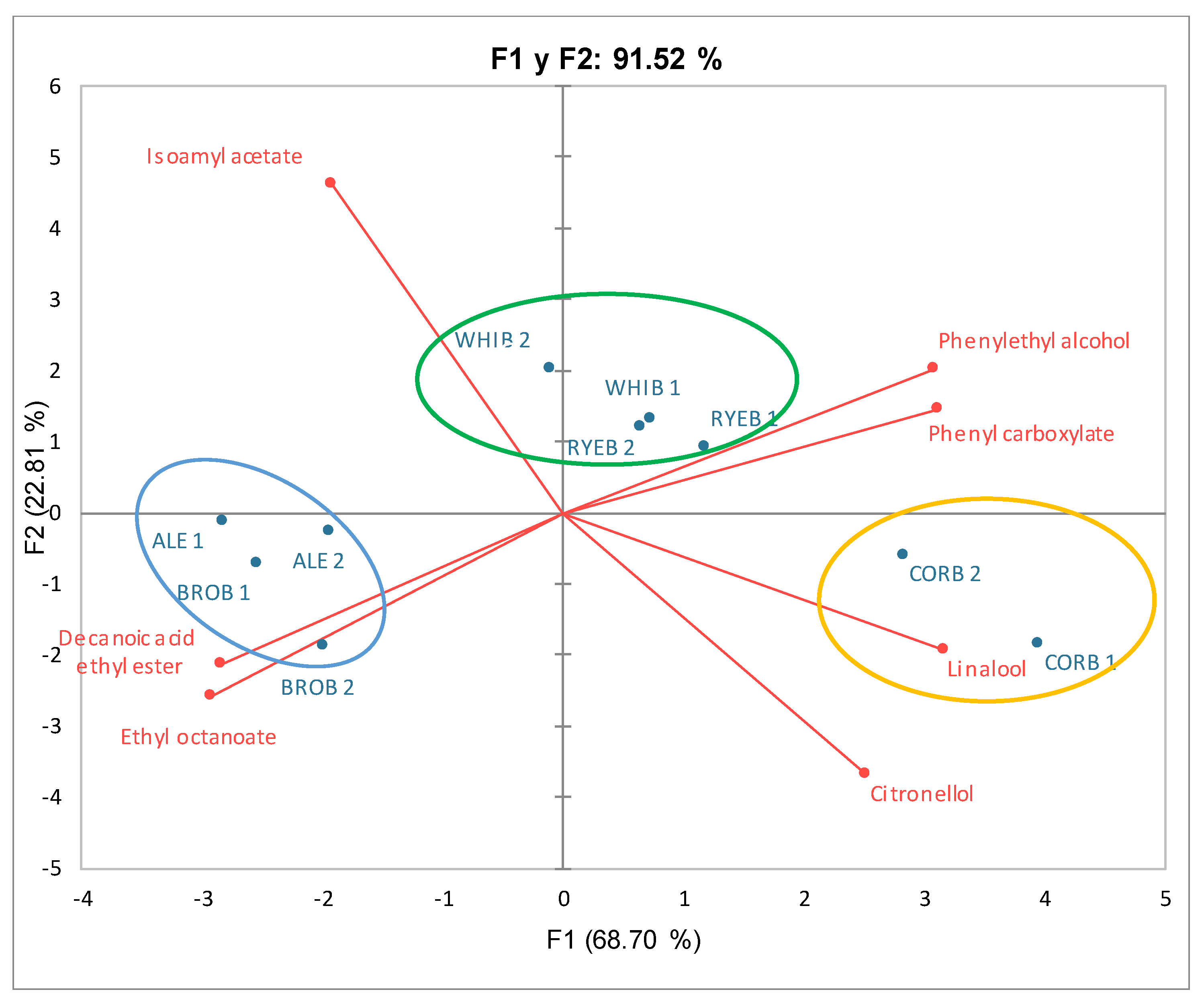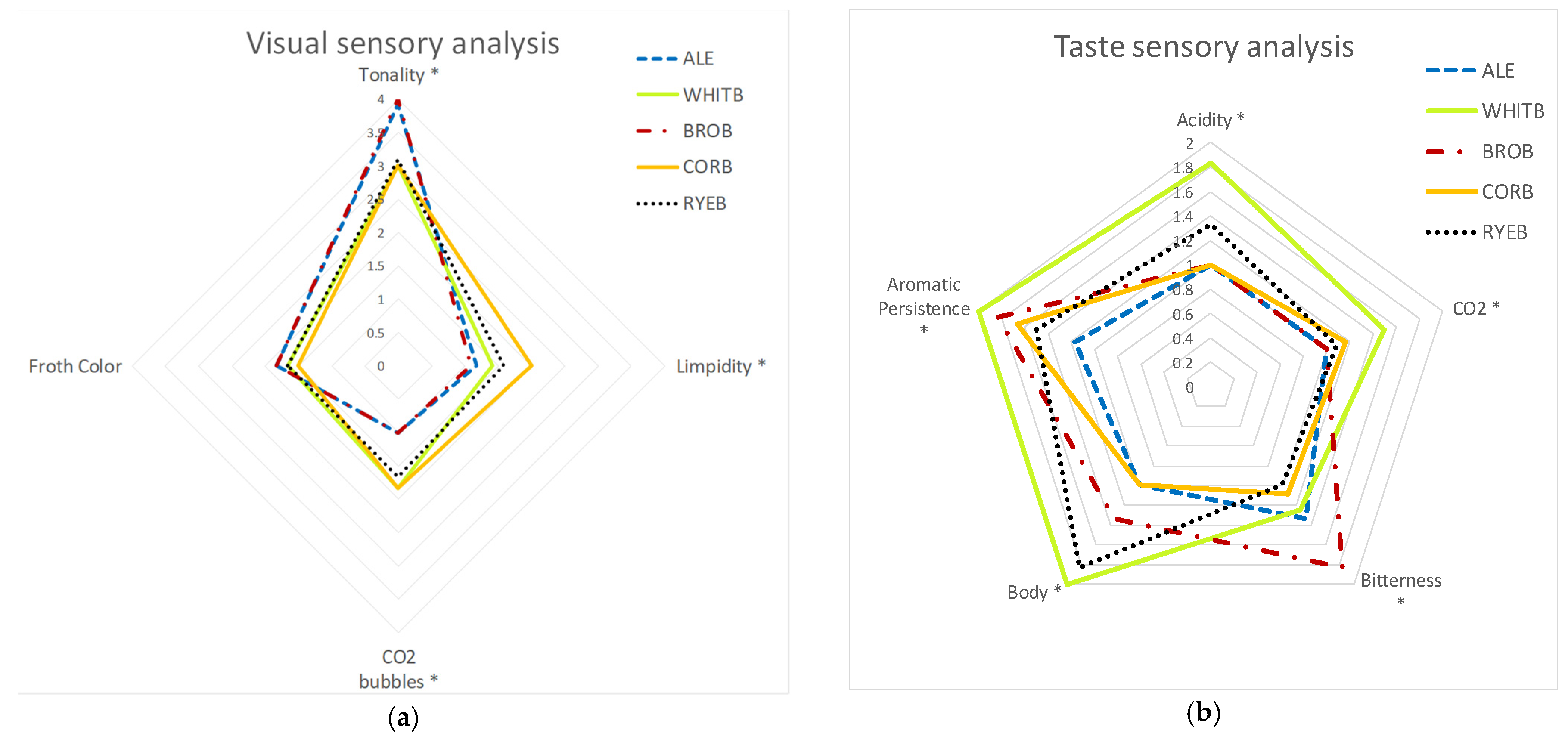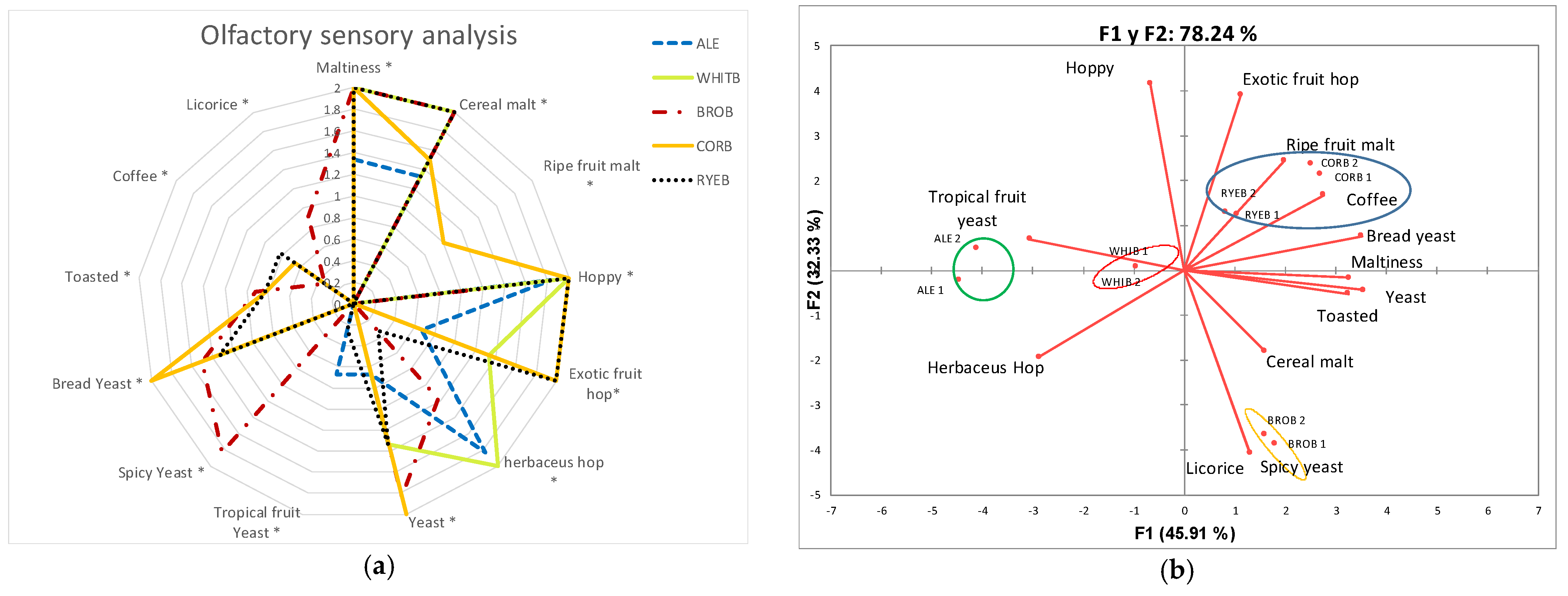Bread as a Valuable Raw Material in Craft Ale Beer Brewing
Abstract
1. Introduction
2. Materials and Methods
2.1. Raw Materials
2.2. Reagents and Chemicals
2.3. Pale Ale Beer Production in the Pilot Brewery
2.4. Physicochemical Analysis
- Turbidity
- Beer turbidity was measured with a turbidimeter (Hanna Instruments, HI 98703 model, Eibar, Spain), and each sample was placed in a transparent glass container with a lid. Each of these containers was placed in the turbidimeter to obtain turbidity values in NTU (nephelometric turbidity units).
- pH: pH was measured with a pH-meter (HACH-LANGE, calibrated sensiON™ + pH3 model, Hospitalet, Spain).
- Acidity: pH-meter measurements were taken in continuous function. An acid–base titration was performed until a pH of 7 was reached. The results were expressed in terms of lactic acid percentage.
- Alcohol By Volume (ABV): an ebulliometer (GAB system, 1010006 model, Moja, Spain) was used. It was calibrated with a standard (distilled water). The boiling temperatures of the standard (water) and the test sample (beer) were compared, and the volumetric alcohol content was calculated with a precision of 0.1 ABV using a ruler scale.
- Color (EBC): color was measured on a spectrophotometer (ThermoFisher Scientific, model 20 Genesys UV-Vis, Madrid, Spain). A beer sample of 3 mL, previously filtered, was introduced into a standard glass cuvette of 1 cm. The absorbance at 430 nm was measured, and distilled water was used as a blank. The obtained value was transformed to the European Brewery Convention (EBC) scale, multiplying the value by 25.
- Dry Extract: dry extract was measured with a thermobalance (Gibertini Eurotherm brand, Novate Milanese, Italy). An identical weight of each beer sample (1 g) was placed on the balance. The water contained in the sample was evaporated, and the remaining solid (dry extract) was weighed. The percentage of dry extract can be obtained directly via the difference with the total sample introduced.
2.5. Total Polyphenol Content and Antioxidant Capacity in Craft Beers
- Total polyphenol content (TPC).
- The total polyphenol content was determined by the Folin–Ciocalteu method by measuring absorbance at 760 nm [22] using the spectrophotometer mentioned above. A calibration line was performed using different concentrations (0.0–30 mg/L) of standard solutions of gallic acid, resulting in the following equation: Y = 0.0243x + 0.0209, R = 0.9959. The concentration of total phenols is expressed as mg of GAE (gallic acid equivalents) per mL−1 of the sample.
- Antioxidant capacity (DPPH)
- The antioxidant capacity of the different beers was measured using the method described by Abderrahim et al. [23]. Beer samples, once filtered and diluted (the 50 μL sample or the blank control), were introduced and mixed with 1000 μL of DPPH (60 μMol L−1 dissolved in methanol 1: 1/10 mMol L−1 Tris-HCl buffer pH 7.5) in a 5 mL volumetric flask. At 0 min, and after 20 min of incubation at room temperature in the laboratory (21 ± 2 °C), a small volume was introduced into 10 mm quartz cuvettes, and absorbance was measured at 520 nm with the spectrophotometer mentioned above. The antioxidant capacity of the beer, expressed in μMol DPPH mL−1, was calculated using the following equation:where A0: control absorbance (DPPH diluted in methanol); At: sample absorbance; Vt: total reaction volume in liters; [DPPH]: DPPH concentration; FD: dilution factor; and mL: sample milliliters used in the reaction.µMol (DPPH mL−1) = ((A0 − At)/A0) × ((Vt [DPPH] × FD)/mL)
2.6. Headspace Gas Chromatography–Mass Spectrometry Analysis (HS-GC–MS)
2.7. Descriptive Sensory Analysis
2.7.1. Panel of Judges
2.7.2. Sensory Evaluation Session
2.8. Statistical Analysis
3. Results and Discussion
3.1. Physicochemical Analysis
3.1.1. Turbidity
3.1.2. Color (EBC Scale)
3.1.3. pH and Acidity
3.1.4. Alcoholic Strength
3.1.5. Dry Extract
3.2. Total Polyphenol Content (TPC) and Antioxidant Capacity in Craft Bread Beers
3.3. GC–MS Detection
3.4. Descriptive Sensory Analysis
3.4.1. Visual and Taste Sensory Analysis
3.4.2. Olfactory Sensory Analysis
4. Conclusions
Author Contributions
Funding
Institutional Review Board Statement
Informed Consent Statement
Data Availability Statement
Acknowledgments
Conflicts of Interest
References
- Callejo, M.J.; Tesfaye, W.; Carmen González, M.; Morata, A. Craft Beers: Current Situation and Future Trends. In New Advances on Fermentation Processes; Martínez-Espinosa, R.M., Ed.; IntechOpen: London, UK, 2020. [Google Scholar] [CrossRef]
- Vera, L.; Aceña, L.; Guasch, J.; Boqué, R.; Mestres, M.; Busto, O. Characterization and Classification of the Aroma of Beer Samples by Means of an MS E-Nose and Chemometric Tools. Anal. Bioanal. Chem. 2011, 399, 2073–2081. [Google Scholar] [CrossRef] [PubMed]
- Olajire, A.A. The Brewing Industry and Environmental Challenges. J. Clean. Prod. 2020, 256, 102817. [Google Scholar] [CrossRef]
- Rachwał, K.; Waśko, A.; Gustaw, K.; Polak-Berecka, M. Utilization of Brewery Wastes in Food Industry. PeerJ 2020, 8, e9427. [Google Scholar] [CrossRef] [PubMed]
- Amienyo, D.; Azapagic, A. Life Cycle Environmental Impacts and Costs of Beer Production and Consumption in the UK. Int. J. Life Cycle Assess. 2016, 21, 492–509. [Google Scholar] [CrossRef]
- Heller, M. Food Product Environmental Footprint Literature Summary: Beer; Center for Sustainable Systems, University of Michigan: Ann Arbor, MI, USA, 2017. [Google Scholar]
- Lalonde, S.; Nicholson, A.; Schenck, R. Life Cycle Assessment of Beer in Support of an Environmental Product Declaration; Institute for Environmental Research and Education (IERE): Vashon, WA, USA, 2013. [Google Scholar]
- Narisetty, V.; Cox, R.; Willoughby, N.; Aktas, E.; Tiwari, B.; Matharu, A.S.; Salonitis, K.; Kumar, V. Recycling Bread Waste into Chemical Building Blocks Using a Circular Biorefining Approach. Sustain. Energy Fuels 2021, 5, 4842–4849. [Google Scholar] [CrossRef]
- Melikoglu, M.; Webb, C. Use of Waste Bread to Produce Fermentation Products. In Food Industry Wastes; Elsevier: Amsterdam, The Netherlands, 2013; pp. 63–76. [Google Scholar]
- Narvhus, J.A.; Srhaug, T. Bakery and Cereal Products. In Food Biochemistry and Food Processing; Hui, Y.H., Ed.; Blackwell Publishing: Ames, IA, USA, 2006; pp. 615–658. [Google Scholar] [CrossRef]
- Suhr, K.I.; Nielsen, P.V. Effect of Weak Acid Preservatives on Growth of Bakery Product Spoilage Fungi at Different Water Activities and PH Values. Int. J. Food Microbiol. 2004, 95, 67–78. [Google Scholar] [CrossRef]
- Leung, C.C.J.; Cheung, A.S.Y.; Zhang, A.Y.-Z.; Lam, K.F.; Lin, C.S.K. Utilisation of Waste Bread for Fermentative Succinic Acid Production. Biochem. Eng. J. 2012, 65, 10–15. [Google Scholar] [CrossRef]
- Pietrzak, W.; Kawa-Rygielska, J. Ethanol Fermentation of Waste Bread Using Granular Starch Hydrolyzing Enzyme: Effect of Raw Material Pretreatment. Fuel 2014, 134, 250–256. [Google Scholar] [CrossRef]
- Cerda, A.; El-Bakry, M.; Gea, T.; Sánchez, A. Long Term Enhanced Solid-State Fermentation: Inoculation Strategies for Amylase Production from Soy and Bread Wastes by Thermomyces sp. in a Sequential Batch Operation. J. Environ. Chem. Eng. 2016, 4, 2394–2401. [Google Scholar] [CrossRef]
- Benabda, O.; Kasmi, M.; Kachouri, F.; Hamdi, M. Valorization of the Powdered Bread Waste Hydrolysate as Growth Medium for Baker Yeast. Food Bioprod. Process. 2018, 109, 1–8. [Google Scholar] [CrossRef]
- Samray, M.N.; Masatcioglu, T.M.; Koksel, H. Bread Crumbs Extrudates: A New Approach for Reducing Bread Waste. J. Cereal Sci. 2019, 85, 130–136. [Google Scholar] [CrossRef]
- Simpson, B.K. Food Biochemistry and Food Processing, 2nd ed.; Wiley-Blackwell: Ames, IA, USA, 2012. [Google Scholar]
- Villacreces, S.; Blanco, C.A.; Caballero, I. Developments and characteristics of craft beer production processes. Food Biosci. 2022, 45, 101495. [Google Scholar] [CrossRef]
- Almeida, J.; Thomas, J.; Murphy, K.; Griffiths, R.; Bengtsson, J. Circular Brew: Life Cycle Assessment of Waste Bread-Based Beer. In Proceedings of the 11th International Conference Life Cycle Assessment of FOOD, Bangkok, Thailand, 17–19 October 2018. [Google Scholar]
- Connolly, R. Case Study: Transformational Entrepreneurship in the UK—“From UK Bread Waste to Global Beer Brand”. In Transformational Entrepreneurship Practices; Maas, G., Jones, P., Eds.; Springer International Publishing: Cham, Switzerland, 2019; pp. 33–54. [Google Scholar] [CrossRef]
- Brewers Association. Beer Styles Study Guide. 2021. Available online: https://www.craftbeer.com/beer/beer-styles-guide (accessed on 18 April 2022).
- Magalhães, L.M.; Santos, F.; Segundo, M.A.; Reis, S.; Lima, J.L.F.C. Rapid Microplate High-Throughput Methodology for Assessment of Folin-Ciocalteu Reducing Capacity. Talanta 2010, 83, 441–447. [Google Scholar] [CrossRef] [PubMed]
- Abderrahim, F.; Arribas, S.M.; Gonzalez, M.C.; Condezo-Hoyos, L. Rapid High-Throughput Assay to Assess Scavenging Capacity Index Using DPPH. Food Chem. 2013, 141, 788–794. [Google Scholar] [CrossRef] [PubMed]
- Liu, M.; Zeng, Z.; Xiong, B. Preparation of novel solid-phase microextraction fibers by sol-gel technology for headspace solid-phase microextraction-gas chromatographic analysis of aroma compounds in beer. J. Chromatogr. A 2005, 1065, 287–299. [Google Scholar] [CrossRef] [PubMed]
- Habschied, K.; Lončarić, A.; Mastanjević, K. Screening of Polyphenols and Antioxidative Activity in Industrial Beers. Foods 2020, 9, 238. [Google Scholar] [CrossRef]
- Vanderhaegen, B.; Neven, H.; Verachtert, H.; Derdelinckx, G. The chemistry of beer aging–A critical review. Food Chem. 2006, 95, 357–381. [Google Scholar] [CrossRef]
- Marques, D.R.; Cassis, M.A.; Quelhas, J.O.F.; Bertozzi, J.; Visentainer, J.V.; Oliveira, C.C.; Monteiro, A.R.G. Characterization of Craft Beers and Their Bioactive Compounds. Chem. Eng. Trans. 2017, 57, 1747–1752. [Google Scholar] [CrossRef]
- Zhao, H.; Chen, W.; Lu, J.; Zhao, M. Phenolic Profiles and Antioxidant Activities of Commercial Beers. Food Chem. 2010, 119, 1150–1158. [Google Scholar] [CrossRef]
- Pai, T.V.; Sawant, S.Y.; Ghatak, A.A.; Chaturvedi, P.A.; Gupte, A.M.; Desai, N.S. Characterization of Indian Beers: Chemical Composition and Antioxidant Potential. J. Food Sci. Technol. 2015, 52, 1414–1423. [Google Scholar] [CrossRef]
- Bertuzzi, T.; Mulazzi, A.; Rastelli, S.; Donadini, G.; Rossi, F.; Spigno, G. Targeted Healthy Compounds in Small and Large-Scale Brewed Beers. Food Chem. 2020, 310, 125935. [Google Scholar] [CrossRef] [PubMed]
- Elrod, S.M.; Greenspan, P.; Hofmeister, E.H. High Phenolic Beer Inhibits Protein Glycation in Vitro. J. Am. Soc. Brew. Chem. 2017, 75, 1–5. [Google Scholar] [CrossRef]
- Gorjanović, S.Ž.; Novaković, M.M.; Potkonjak, N.I.; LeskoŠek-Čukalović, I.; Sužnjević, D.Ž. Application of a Novel Antioxidative Assay in Beer Analysis and Brewing Process Monitoring. J. Agric. Food Chem. 2010, 58, 744–751. [Google Scholar] [CrossRef] [PubMed]
- Nardini, M.; Foddai, M.S. Phenolics Profile and Antioxidant Activity of Special Beers. Molecules 2020, 25, 2466. [Google Scholar] [CrossRef] [PubMed]
- Piazzon, A.; Forte, M.; Nardini, M. Characterization of Phenolics Content and Antioxidant Activity of Different Beer Types. J. Agric. Food Chem. 2010, 58, 10677–10683. [Google Scholar] [CrossRef]
- Mitić, S.S.; Paunović, D.Đ.; Pavlović, A.N.; Tošić, S.B.; Stojković, M.B.; Mitić, M.N. Phenolic Profiles and Total Antioxidant Capacity of Marketed Beers in Serbia. Int. J. Food Prop. 2014, 17, 908–922. [Google Scholar] [CrossRef]
- Fumi, M.D.; Galli, R.; Lambri, M.; Donadini, G.; De Faveri, D.M. Effect of full-scale brewing process on polyphenols in Italian all-malt and maize adjunct lager beers. J. Food Compos. Anal. 2011, 24, 568–573. [Google Scholar] [CrossRef]
- Taylor, J.R.N.; Dlamini, B.C.; Kruger, J. 125th Anniversary Review: The science of the tropical cereals sorghum, maize and rice in relation to lager beer brewing. J. Inst. Brew. 2013, 119, 1–14. [Google Scholar] [CrossRef]
- Zapata, P.J.; Martínez-Esplá, A.; Gironés-Vilaplana, A.; Santos-Lax, D.; Noguera-Artiaga, L.; Carbonell-Barrachina, Á.A. Phenolic, Volatile, and Sensory Profiles of Beer Enriched by Macerating Quince Fruits. LWT 2019, 103, 139–146. [Google Scholar] [CrossRef]
- Alvim, R.P.R.; Gomes, F.D.C.O.; Garcia, C.F.; Vieira, M.D.L.A.; Machado, A.M.D.R. Identification of Volatile Organic Compounds Extracted by Headspace Solid-Phase Microextraction in Specialty Beers Produced in Brazil: Identification of Volatile Compounds in Specialty Beers. J. Inst. Brew. 2017, 123, 219–225. [Google Scholar] [CrossRef]
- Da Silva, G.C.; da Silva, A.A.S.; da Silva, L.S.N.; de, O. Godoy, R.L.; Nogueira, L.C.; Quitério, S.L.; Raices, R.S.L. Method Development by GC–ECD and HS-SPME–GC–MS for Beer Volatile Analysis. Food Chem. 2015, 167, 71–77. [Google Scholar] [CrossRef] [PubMed]
- He, L.; Gao, Y.; Zhao, L. Online Coupling of Bubbling Extraction with Gas Chromatography-Mass Spectrometry for Rapid Quantitative Analysis of Volatiles in Beer. J. Chromatogr. A 2022, 1665, 462800. [Google Scholar] [CrossRef] [PubMed]





| Grain Malt | Pilsen EBC 3 (Weyermann, Bamberg, Germany) |
| Munich Type I EBC 12 (Weyermann, Bamberg, Germany) | |
| Cara Rye EBC 150 (Weyermann, Bamberg, Germany) | |
| Biscuit EBC 45 (Castle Malting, Verviers, Belgium) | |
| Hops Pellets | Centennial 9.6% a.a. (Laguilhoat, Fuenlabrada, Spain) |
| Cascade 6.7% a.a (Laguilhoat, Fuenlabrada, Spain) | |
| Simcoe 13.6% a.a. (Laguilhoat, Fuenlabrada, Spain) | |
| Bread | White wheat bread |
| Whole wheat bread | |
| Corn bread | |
| Rye bread | |
| Yeast | SafAle S-04 (Fermentis, Marcq-en-Baroeul, France) |
| SafAle F-2 (Fermentis, Marcq-en-Baroeul, France) | |
| Water | Monte Pinos (Carbónicas Navalpotro S.A, Almazán, Spain) |
| Variety of Hops | IBU | Alpha Acids (%) | Boil Min. | Weight (g) |
|---|---|---|---|---|
| Centennial | 15 | 9.6 | 1 | 5.79 |
| Cascade | 10 | 6.7 | 30 | 7.86 |
| Simcoe | 5 | 13.6 | 59 | 3.34 |
| Beer/Analysis | Turbidity | Color (EBC) | pH | Acidity (% Lactic Acid) | ABV (%) | Dry Extract (%) |
|---|---|---|---|---|---|---|
| ALE 1 | 932.33 ± 29.57 C | 25.46 ± 0.03 A | 3.83 ± 0.06 ABC | 0.03 ± 0.01 A | 4.33 ± 0.06 AB | 5.71 ± 0.03 A |
| ALE 2 | 975.67 ±15.63 B | 24.06 ± 0.01 B | 3.74 ± 0.01 CD | 0.03 ± 0.01 A | 4.33 ± 0.07 AB | 5.53 ± 0.11 AB |
| WHIB 1 | 907.67 ± 8.33 C | 17.82 ± 0.04 E | 3.93 ± 0.01 A | 0.03 ± 0.01 A | 4.21 ± 0.07 B | 5.35 ± 0.05 BC |
| WHIB 2 | 935.00 ± 3.61 C | 16.33 ± 0.04 F | 3.88 ± 0.04 AB | 0.03 ± 0.01 A | 4.37 ± 0.15 AB | 5.03 ± 0.05 DE |
| BROB 1 | 1061.00 ± 3.46 A | 19.40 ± 0.11 C | 3.85 ± 0.04 ABC | 0.02 ± 0.01 A | 4.21 ± 0.10 B | 5.03 ± 0.08 DE |
| BROB 2 | 1027.67 ± 6.51 A | 21.00 ± 0.21 D | 3.77 ± 0.01 BC | 0.03 ± 0.01 A | 4.58 ± 0.07 A | 4.94 ± 0.03 E |
| CORB 1 | 743.67 ± 0.58 E | 11.74 ± 0.05 I | 3.81 ± 0.02 ABC | 0.02 ± 0.01 A | 3.39 ± 0.12 C | 3.96 ± 0.06 G |
| CORB 2 | 689.67 ± 8.39 F | 11.75 ± 0.02 I | 3.85 ± 0.02 ABC | 0.02 ± 0.01 A | 3.49 ± 0.25 C | 4.31 ± 0.16 F |
| RYE 1 | 834.67 ± 7.51 D | 13.24 ± 0.08 G | 3.64 ± 0.11 D | 0.02 ± 0.01 A | 4.25 ± 0.08 AB | 5.01 ± 0.03 DE |
| RYE 2 | 708.00 ± 19.31 EF | 15.11 ± 0.10 H | 3.85 ± 0.02 ABC | 0.02± 0.01 A | 4.47 ± 0.06 AB | 5.23 ± 0.06 CD |
| Beer/Compound | Isoamyl Acetate | Phenyl Carboxylate | Linalool | Phenylethyl Alcohol | Ethyl Octanoate | Citronellol | Decanoic Acid Ethyl Ester |
|---|---|---|---|---|---|---|---|
| Retention Time (min.) | 4.83 | 8.64 | 8.72 | 8.94 | 10.28 | 10.75 | 13.24 |
| ALE 1 | 32.45 | 3.49 | 4.59 | 18.61 | 12.05 | 2.40 | 9.09 |
| ALE 2 | 28.39 | 5.33 | 4.64 | 21.28 | 15.08 | 2.26 | 5.97 |
| WHIB 1 | 29.03 | 7.67 | 5.31 | 31.99 | 6.37 | 2.54 | 0.73 |
| WHIB 2 | 33.33 | 7.69 | 5.20 | 26.98 | 6.46 | 1.87 | 0.89 |
| BROB 1 | 25.94 | 3.69 | 4.17 | 15.35 | 16.39 | 2.05 | 4.12 |
| BROB 2 | 23.50 | 5.07 | 5.19 | 14.03 | 18.58 | 2.97 | 5.60 |
| CORN 1 | 18.20 | 8.63 | 9.72 | 33.87 | 3.41 | 5.25 | 0.37 |
| CORN 2 | 21.40 | 10.29 | 8.29 | 30.86 | 5.71 | 3.79 | 0.71 |
| RYE 1 | 28.84 | 7.80 | 6.55 | 28.78 | 4.40 | 2.93 | 0.54 |
| RYE 2 | 28.11 | 8.46 | 5.94 | 27.43 | 6.52 | 2.08 | 0.62 |
Publisher’s Note: MDPI stays neutral with regard to jurisdictional claims in published maps and institutional affiliations. |
© 2022 by the authors. Licensee MDPI, Basel, Switzerland. This article is an open access article distributed under the terms and conditions of the Creative Commons Attribution (CC BY) license (https://creativecommons.org/licenses/by/4.0/).
Share and Cite
Martin-Lobera, C.; Aranda, F.; Lozano-Martinez, P.; Caballero, I.; Blanco, C.A. Bread as a Valuable Raw Material in Craft Ale Beer Brewing. Foods 2022, 11, 3013. https://doi.org/10.3390/foods11193013
Martin-Lobera C, Aranda F, Lozano-Martinez P, Caballero I, Blanco CA. Bread as a Valuable Raw Material in Craft Ale Beer Brewing. Foods. 2022; 11(19):3013. https://doi.org/10.3390/foods11193013
Chicago/Turabian StyleMartin-Lobera, Carlos, Fernando Aranda, Patricia Lozano-Martinez, Isabel Caballero, and Carlos A. Blanco. 2022. "Bread as a Valuable Raw Material in Craft Ale Beer Brewing" Foods 11, no. 19: 3013. https://doi.org/10.3390/foods11193013
APA StyleMartin-Lobera, C., Aranda, F., Lozano-Martinez, P., Caballero, I., & Blanco, C. A. (2022). Bread as a Valuable Raw Material in Craft Ale Beer Brewing. Foods, 11(19), 3013. https://doi.org/10.3390/foods11193013






